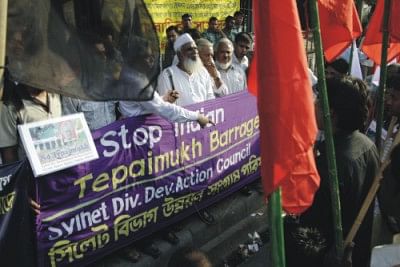Tipaimukh issue needs bi-partisan approach

A.m.ahad/drik News
THE last few weeks have witnessed emotion, anger, accusations and counter charges. The opposition, busy as usual with negative expressions outside the Jatiyo Sangshad, has tried its best to influence public opinion against India's decision to construct the Tipaimukh Dam Civil society, hydrologists, economists and water 'experts' have also been free with opinions about the possible post-Tipaimukh catacysmic scenario and made the situation more complex.
The Tipaimukh issue has raised temperature both within and outside the Jatiyo Sangshad. The recalcitrance of the Bangladesh Nationalist Party (BNP) and its affiliates to nominate one or more of its Members of Parliament for inclusion within the parliamentary team visiting the Tipaimukh site, has demonstrated once again the Opposition's desire to play politics, even with areas that affect national interest. A separate BNP approach will only impair the national initiative. The resolution of this issue needs a bi-partisan approach and the solution has to be found through negotiation and dialogue.
Before moving forward, I need to first distinguish for my readers between a dam and a barrage.
Dams are built to contain water within a reservoir at a higher level than that normally associated at that point within that river. It is used to also facilitate controlled discharge of stored water through turbines to generate electricity. However the quantum of water flow discharge downstream of the Dam through turbines and spillways is to a great extent dependent upon season-wise fluctuations in rainfall. Substantial or irregular fluctuations in water flow downstream can create floods, water logging and water holds.
A barrage is constructed to contain water at a certain level that would facilitate the diversion of stored water for other use. Such storage or withdrawal or diversion in most cases are dependent also on any agreement that might have been entered upon with the lower riparian State whose water flow has been directly affected by the construction of such a barrage.
Unfortunately as has been evidenced in the case of the Farakka barrage, there are certain downsides, which have slowly emerged over time. I point out in this regard to the reduction in the water flow at the barrage site due to unilateral withdrawal of water at various points upstream of the barrage by institutions or individuals in the Indian States of UP and Bihar. This is directly affecting availability of water during the lean months of winter and impacting on agriculture, the environment and navigability.
Now let us look at the background of the Tipaimukh Dam. Indian planners thought of this project in the early seventies and subsequently discussed the possibility of it as a primary project, most superficially, in 1979 and 1983 with Bangladesh. Later on, the Indian authorities did not share any details or studies pertaining to this project.
In 2003, our people associated with the water sector found out that the Tipaimukh Dam was being proposed at a location about half a kilometer downstream from the confluence of the Barak River and the Tulvai River, near the south-west corner of the Indian Manipur State, about 200 km. upstream of the Bangladesh border. Due to ensuring protests both within the Manipur and Mizoram States of India and in Bangladesh, the construction of the Dam was shelved for the time being.
In 2004 India assured Bangladesh that no further steps would be taken without consultation with our authorities. Nevertheless, contrary to such assurance, India floated a tender in 2005, opened it in 2006 and allegedly finalised the design in 2008. The foundation stone for the Dam was later laid in the same year.
It is now anticipated that the construction of this rock-filled Dam with a 178-meter reservoir and a water containment capacity of 16.m. cu.m will be completed by 2012. The electricity generation capacity of the Dam will be 1500 MW, but firm generation in the beginning is expected to be about 412 MW.
Water experts in Bangladesh are equally worried not only about the possible effects of the Tipaimukh Dam but also what might happen as a result of the construction of the Fulertal barrage. Sufficient details are not yet available about this project but there are indications that this brrage is going to be built approximately 100 km downstream of Tipaimukh Dam and 100 km diagonally upstream of Amalshid in Sylhet, Bangladesh.
Many apprehend that this barrage is being built to regulate water flow downstream from the site of the Tipaimukh Dam. If that happens, it will have a direct bearing on the flow of Surma, Kushiyara and the Meghna rivers.
The third cause for anxiety among environmentalists, geologists, hydrologists and seismologists in Bangladesh relates to the topographic features of this Dam. Several workshops in Dhaka have underlined the drainage pattern of the Barak River and also the structural and tectonic lineaments of the proposed Dam's adjoining region. They have suggested that there is very high seismic risk in that area because of the presence of different Fault systems and the proximity of such Faults to the Jafflong Thrust, the Naga Thrust and the Disang Thrust.
There is general consensus among the civilian population in densely populated north eastern Bangladesh that lack of constancy of water flow quantity arising out of the construction of the Dam and the barrage will affect the environment, agriculture, pisciculture and water quality. It is also felt that changes in natural flow will enhance siltation and affect navigability.
The Indian authorities need to remember that the UN Convention on the Non-Navigational Uses of International Watercourses might not as yet have come into force but there are still principles of equity that apply. There is recognition and general acceptance that water management and sharing has to be done in a reasonable manner that would help riparian countries to attain optimal sustainable utilization without causing significant harm to other co-riparian nations.
Lastly, there are the provisions contained in Article 6 of the Ganges Water Sharing Treaty of 1996, which stipulate that both countries will have to agree with regard to management of all the common rivers. We need to thank the past Awami League Administration for their foresight at the time of signing this Treaty.
What is required today is transparency and political will. One hopes that the visit of our Parliamentary delegation will be followed not only by intensive discussion on the basis of shared data between relevant experts from both countries but also meetings between the two political leaderships. An acceptable equation has to be reached between sovereign rights and national interests. There has to be a careful scrutiny and a bi-partisan approach in this context within Bangladesh. Emotion must not be allowed to affect pragmatism.
Muhammad Zamir is a former Secretary and Ambassador and can be reached at [email protected]

 For all latest news, follow The Daily Star's Google News channel.
For all latest news, follow The Daily Star's Google News channel. 



Comments